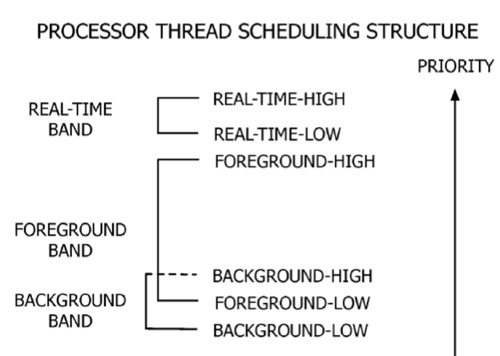An Apple patent (number 20110252430) for “opportunistic multitasking” has appeared at the US Patent & Trademark Office. Services for a personal electronic device are provided through which a form of background processing or multitasking is supported.
The disclosed services permit user applications to take advantage of background processing without significant negative consequences to a user’s experience of the foreground process or the personal electronic device’s power resources. To effect the disclosed multitasking, one or more of a number of operational restrictions may be enforced. By way of example, an application that may normally be placed into the background state may instead be terminated if it controls a lock on a shared system resource. The inventors are Gregory R. Chapman, Richard Schreyer and Thomas B. Duffy Jr.
Here’s Apple’s background and summary of the invention: “Power constrained, hand-held devices (e.g., mobile phones, personal entertainment devices, and electronic pad computers) are resource limited compared to larger, fixed, systems such as desk-top, workstation and notebook computers. In such systems, the computational power available simply cannot support the execution of a large number of concurrent processes/threads without significantly degrading the user experience and consuming the device’s limited power resources.
“In light of this recognition, system designers for these types of devices have traditionally permitted a limited multitasking capability at the operating system level (e.g., for core system functions), but have not supported multitasking at the user application level. While this approach has the benefit of minimizing the drain on the device’s limited power resources, it also limits the ability to provide the user (via a user application) with an interactive environment.
“Services for a personal electronic device are provided through which a form of background processing or multitasking is supported. The disclosed services permit user applications to take advantage of background processing without significant negative consequences to a user’s experience of the foreground process or the personal electronic device’s power resources. Implementation of the disclosed services may be substantially transparent to the executing user applications and, in some cases, may be performed without the user application’s explicit cooperation. To effect the disclosed multitasking, a number of operational restrictions may be enforced. A consequence of such restrictions may be that a process will not be able to do in background, what it may be able to do if it were in the foreground.
“In one service, a foreground user application is transitioned to a non-executing state as it is moved out of the foreground state. In another service, a background process is given a maximum amount of time to complete a task before it is transitioned to a non-executing state. In still another service, audio applications (e.g., user applications generating or recording audio signals) are permitted to execute in background until, and unless, they are paused by a user. In yet another service, communication sockets instantiated for a user application may be maintained even if the user application instantiating same, is placed in a non-executing state (e.g., a voice over Internet Protocol user application).
“One illustrative type of application that can take advantage of this service is voice over Internet protocol (VOIP) user applications. In still other embodiments, user applications are permitted to receive notifications (e.g., location events) when in the non-executing state. Each of the disclosed services relies on or uses one or more restrictions that, in operation, can interfere with or prevent full-time multitasking operations. That is, the disclosed services permit multitasking only when it will not significantly interfere with the foreground process or unduly utilize the personal electronic device’s power.”
— Dennis Sellers

